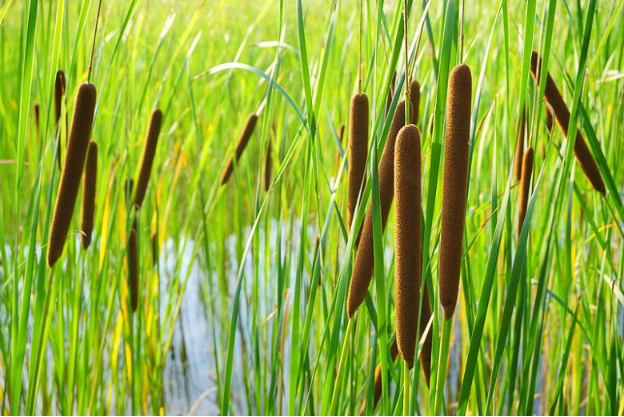

Broadleaf Cattail, Common Cattail, Great Reedmace, Bulrush, Asparagus of the Cossacks, Baccobolts, Blackcap, Blackhead, Bull Segg, Candlewick, Cat O'Nine Tails, Cat's Tail, Cat Tail, Dod, Flax Tail, March Beetle, Marsh Beetle, Marsh Pestle, Mat Reed, Nailrod, Water Torch
Typha latifolia (Broadleaf Cattail) is a vigorous, marginal aquatic perennial forming a dense clump of stout, cylindrical, and unbranched stems up to 7 ft. long (210 cm). The narrow, upright, linear, light green leaves turn golden brown in the fall. In spring to early summer, the plant bears cylindrical inflorescences composed of tiny male, staminate flowers in the upper portion and female, pistillate flowers below. Over 1000 flowers may be produced on one plant. The male flowers are golden yellow at the time they shed their pollen, then they disintegrate, leaving a naked stalk tip. The densely packed female spike turns from green to rich brown as the seeds mature. The fertilized flowers produce single-seeded, nutlike achenes with long, slender hairs that allow for wind and water transport of the seeds. The fruiting spikes usually persist to early winter before disintegrating. They are widely popular for cut flower arrangements. Broadleaf Cattail has tough, stout, coarse, and extensive rhizomes. It spreads to form dense colonies in shallow water, where it provides a favorable habitat for red-winged blackbirds, as well as other marsh birds, and muskrats. Nutria, muskrats and beavers enjoy the shoots and roots, while teal ducks or finches eat the seeds. Native to marshes, swamps and wetlands in North America, Europe and Asia, Broadleaf Cattail can be used as an accent plant or for a thick privacy screen. It can grow in a pond, water garden, bog garden or in a container that does not drain. Broadleaf Cattail is aggressive and should not be introduced without thought as to how to control it. Site plants carefully because the roots go deep and are hard to eradicate once established.
Native to North America, Europe and Asia
| Requirement | |
|---|---|
| Hardiness | 3,4,5,6,7,8,9,10 |
| Heat Zones | 2,3,4,5,6,7,8,9 |
| Climate Zones | 2, 3, 4, 5, 6, 7, 8, 9 |
| Plant Type | Perennials, Aquatic Plants |
| Plant Family | Typhaceae |
| Exposure | Full Sun, Partial Sun |
| Season of Interest | Spring, Summer, Fall, Winter, Early Spring, Mid Spring, Late Spring, Early Summer, Mid Summer, Late Summer |
| Height | 4' - 5', 5' - 6', 6' - 7' |
| Spread | 4' - 5', 5' - 6', 6' - 7' |
| Water Needs | High |
| Maintenance | Average |
| Soil Type | Clay, Loam, Acid, Alkaline, Neutral |
| Characteristics | Showy, Evergreen, Attracts Hummingbirds, Wet Soil Tolerant |
| Garden Styles | Coastal Garden, Cutting Garden, Traditional Garden |
| Planting Place | Bog Gardens, Ponds and Streams, Rain Gardens, Water Gardens |